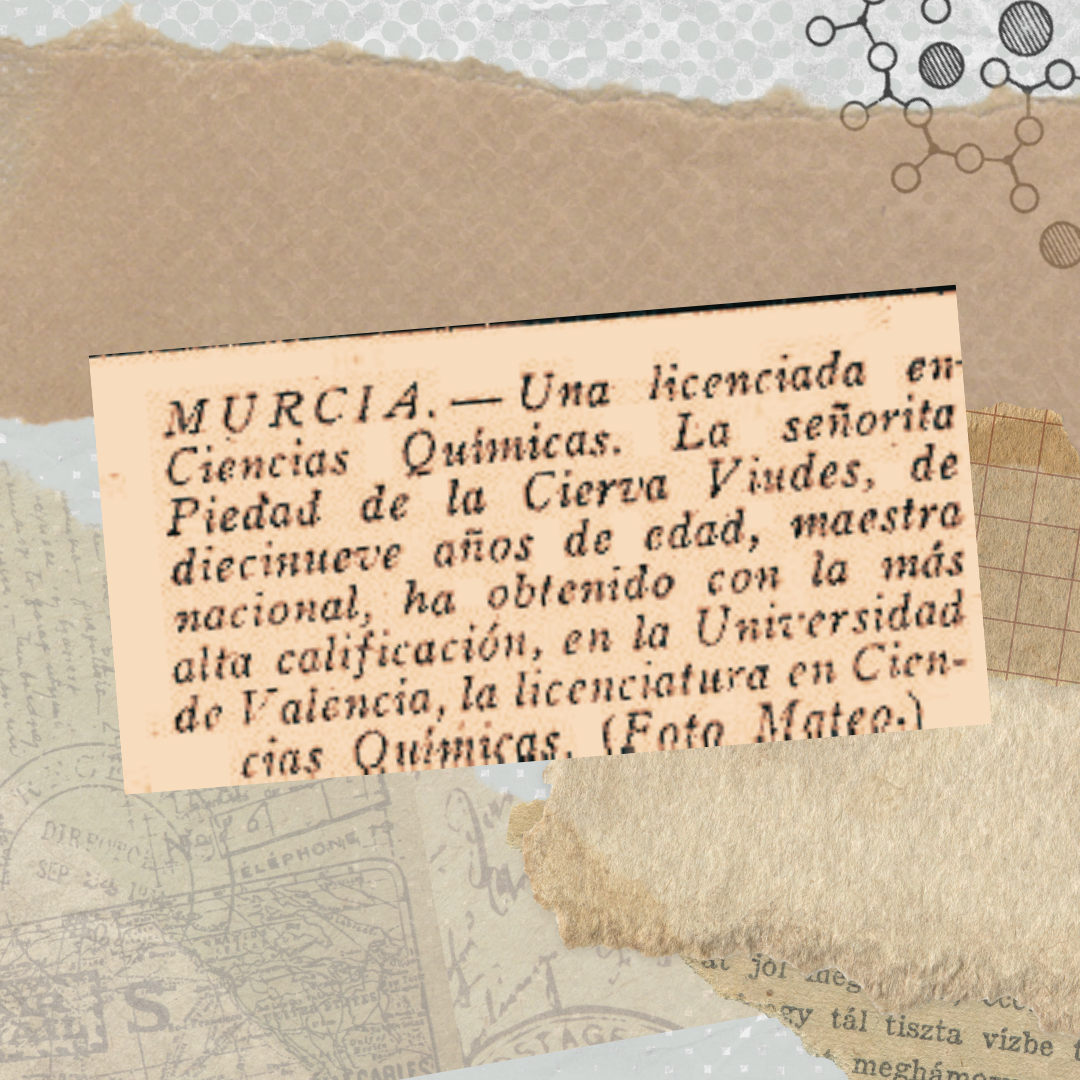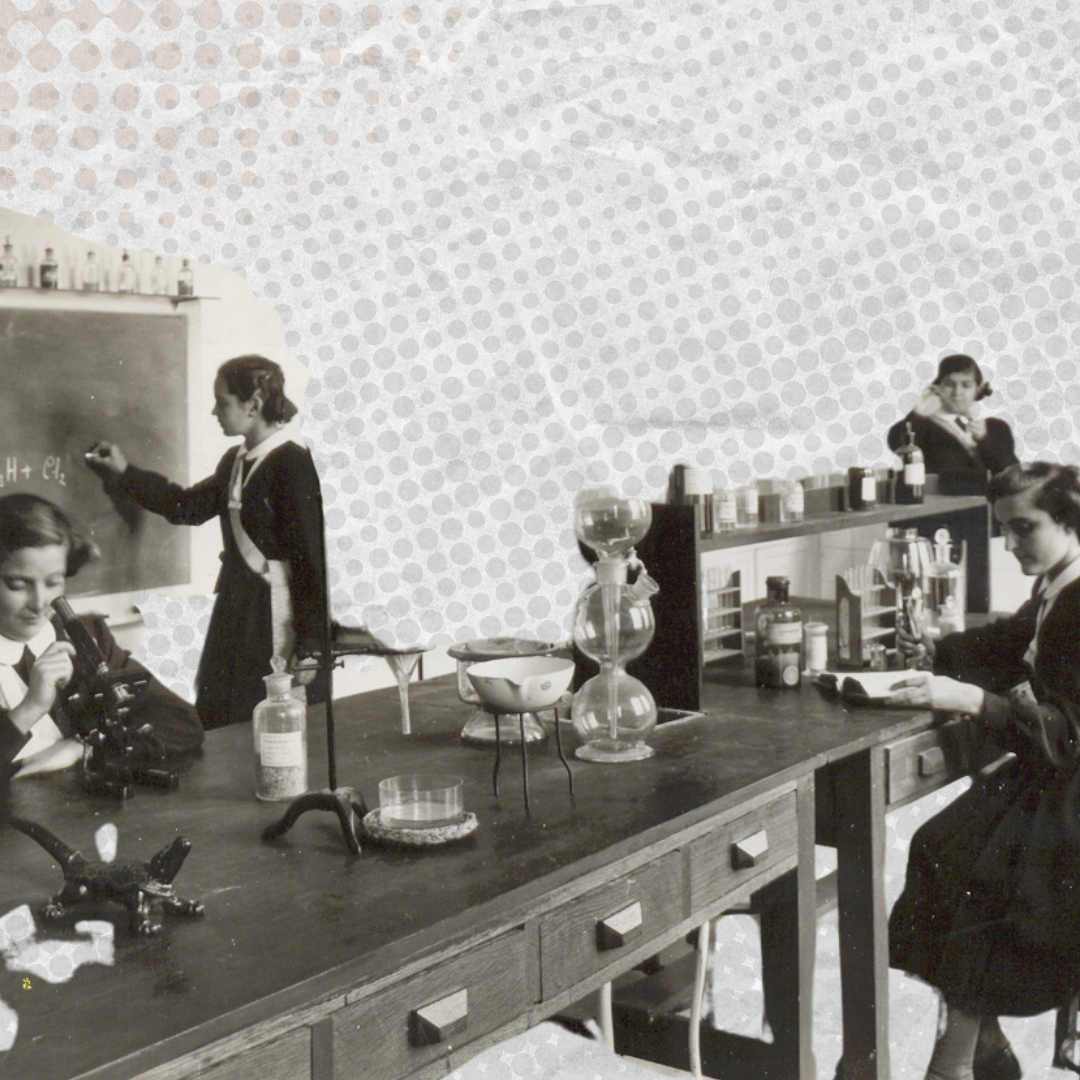exhibition
Main Library
University of Navarra
19/11/2024 - 14/03/2025
Discover Piedad de la Cierva (1913-2007), a Spanish scientist who pioneered the programs of study X, optical glass and refractory bricks.
Visitors can enjoy an art installation that recreates an environment from research with scientific materials and from laboratory. Inspired by technological functionalism, it highlights the value of mid-century objects, creating an immersive and engaging environment.
Throughout her career, Piedad de la Cierva led pioneering projects at research .
His curiosity and commitment to science left an indelible mark on the Spanish research .
-
1913
June 1
Piedad de la Cierva was born in Murcia on June 1, 1913. She was the eldest of three brothers, Julián, Juan and Francisco. She grew up in a cultured and enlightened environment.

-
1928
University of Murcia
In 1928 he finished the high school diploma with all the subjects passed with A and the award Extraordinary. She began her programs of study in the School of Sciences of the University of Murcia. There she was the only woman in her class.

-
1929
University of Valencia
Piedad moved to Valencia to continue her studies programs of study. In the School of Chemistry she was the only woman in her class, being one of the lucky ones who was part of that 6% of student body female of the total number of university students in Spain.

-
1932
Bachelor of Science
She graduated in Science from the University of Valencia and received the Extraordinary award of licentiate degree. She moved to Madrid and began studying as a scholar in the X department at the Rockefeller Institute in Madrid, under the direction of Julio Palacios.

-
1935
doctorate at the Central University of Madrid
He defended his thesis : "The chemical factors of sulfur and lead" and obtained the grade of A and the award Extraordinary of doctorate. In addition, he received a scholarship to study at Universitetet Institute for Teoretisk Fysik in Copenhagen.

-
1936
Return to Spain
After his programs of study in Denmark he returned to Spain with the assignment to assemble a β-particle counter. However, the Civil War put an end to project. During the first year of the war he took refuge in the Norwegian Embassy, where he became friends with the physicist José María Otero Navascués.

-
1937
High school teacher
After leaving the Norwegian embassy, Piedad and her mother and siblings settled in Osuna, Seville. During those years she was a high school physics teacher and Chemistry .

-
1939
At the end of the civil war, Piedad tried to resume her scientific activity on artificial radiation. But when she returned to Madrid, status was not favorable for her research. A few months later, the physicist and sailor José María Otero Navascués offered her a job in the optics section to promote the research and manufacture of optical instruments for the Navy.

-
1941
Oppositions for Chair of Physicochemistry
It was a particularly difficult year for Piedad. Although she took the competitive examinations for the Chair in Physicochemistry at the universities of Madrid, Murcia and Seville, she did not manage to obtain the position. Convinced that her condition as a woman had been an obstacle, she decided to leave the university degree program and focus entirely on research, a field that had always been more rewarding for her result .

-
1945
LTIEMA
The creation of the laboratory and Workshop of research of the General Staff of the Navy (LTIEMA) meant a new leap for the Murcian scientist. As director of the new center, Otero Navascués managed to get De la Cierva hired by the Navy to work at laboratory. His mission statement was to apply the methods learned to the work of industrialization of optical glass to be carried out in this institute.

-
1946
First award of the Academy of Sciences
She was the first woman to receive recognition from this Degree. Her publication was entitled "Anti-reflection films on glass surfaces by means of the high vacuum and evaporation technique of fluoride salts subjected to high temperatures".

-
1948
Travel to the United States
Piedad traveled to the United States to train in the advanced techniques being developed there. During her two-year stay, she collaborated with the National Bureau of Standards (NBS) in Washington and got the Navy to support her project with a scholarship. This experience provided him with a unique opportunity to train and lead pioneering projects upon his return to Spain.

-
1950
Optical glass
Upon his return to Madrid, Piedad de la Cierva formed a team consisting of four chemists, a teaching assistant of laboratory and five workers. They built the first test furnace and began to obtain the glass. For this work Piedad and his team won the 1st technical award research 'Juan de la Cierva'.

-
1952
Vocation
Throughout her life, Piedad considered joining a religious congregation, but believed that her spiritual vocation should be aligned with her scientific degree program . Her meeting with Opus Dei was core topic in this search.

-
1966
New line of research
Piedad de la Cierva initiated a new line of research on the use of rice husk as an insulator in the manufacture of refractory bricks for ship boilers and other industrial furnaces. Thanks to this work, she and her team were awarded the prestigious award 'Juan de la Cierva'. For this project, Piedad sought the partnership of young scientists, to whom she directed their doctoral thesis , although she could not officially appear as director because she was not a professor. One of them was Blessed Guadalupe Ortiz de Landázuri.

-
1976
Retirement
After a long scientific career, Piedad retired. From then on, she dedicated herself to the service of others until an advanced age.

-
1992
His memoirs
Piedad began to experience visual problems that worsened over time. Knowing that this could affect her in the future, she decided to start writing her memoirs.

-
2007
December 31, 2009
He passed away at the age of 93, after suffering from cognitive impairment.

Driven by her perseverance and passion for science, she managed to break through and succeed in a male-dominated academic world.
Her bequest inspires new generations of women to pursue their scientific dreams with the same submission and determination.
VISITS
SCHEDULE GENERAL
Monday to Friday: from 9:00 to 20:00
Saturdays: 09:00 to 14:00
entrance free
SCHOOL ACTIVITIES 2025
From 1st to 6th grade of primary school: Storytelling
Tuesday and Thursday: 11:00 am
11 and 13/ FEB
25 and 27/ FEB
4 and 6/ MAR
From 1st to 4th ESO: Lectures
Wednesday and Friday: 11:00 am
12 and 14/ FEB
26 and 28/ FEB
5 and 7/ MAR
Registration: museociencias@unav.es

PARKING AND TRANSPORTATION

Parking for school visits: University of Navarra Dining Hall.

One Ride: anchors on the side of the Library Services.

Villavesa: nº 1 stop source de Hierro;
nº 5 and nº 23 in front of Mendaur high school .


